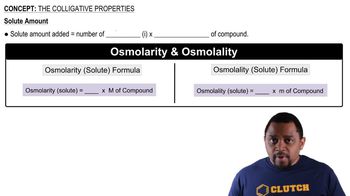Calculate the freezing point and boiling point of each aqueous solution, assuming complete dissociation of the solute. a. 0.100 m K2S b. 21.5 g of CuCl2 in 4.50⨉102 g water
Ch.14 - Solutions

Chapter 14, Problem 88
Is the question formulated correctly for calculating the freezing point and boiling point of each solution, assuming complete dissociation of the solute? For the following: a. 10.5 g FeCl3 in 1.50 * 10^2 g water b. 3.5% KCl by mass (in water) c. 0.150 m MgF2.
 Verified step by step guidance
Verified step by step guidance1
insert step 1> Determine the molality (m) of each solution. For FeCl3, calculate the number of moles of FeCl3 using its molar mass, then divide by the mass of water in kilograms. For KCl, use the given mass percentage to find the mass of KCl in 100 g of solution, then calculate molality. For MgF2, the molality is already given as 0.150 m.
insert step 2> Calculate the van't Hoff factor (i) for each solute, which represents the number of particles the solute dissociates into. For FeCl3, i = 4 (Fe^3+ and 3 Cl^-). For KCl, i = 2 (K^+ and Cl^-). For MgF2, i = 3 (Mg^2+ and 2 F^-).
insert step 3> Use the freezing point depression formula: \( \Delta T_f = i \cdot K_f \cdot m \), where \( K_f \) is the cryoscopic constant for water. Calculate \( \Delta T_f \) for each solution.
insert step 4> Use the boiling point elevation formula: \( \Delta T_b = i \cdot K_b \cdot m \), where \( K_b \) is the ebullioscopic constant for water. Calculate \( \Delta T_b \) for each solution.
insert step 5> Determine the new freezing and boiling points by subtracting \( \Delta T_f \) from the normal freezing point of water (0°C) and adding \( \Delta T_b \) to the normal boiling point of water (100°C).
Key Concepts
Here are the essential concepts you must grasp in order to answer the question correctly.
Colligative Properties
Colligative properties are physical properties of solutions that depend on the number of solute particles in a given amount of solvent, rather than the identity of the solute. These properties include boiling point elevation and freezing point depression, which are crucial for calculating the changes in phase transitions of solutions when solutes are added.
Recommended video:
Guided course

Colligative Properties
Dissociation of Ionic Compounds
Ionic compounds, such as FeCl3 and KCl, dissociate into their constituent ions when dissolved in water. This dissociation increases the number of solute particles in the solution, which directly affects the colligative properties. For example, FeCl3 dissociates into four ions (one Fe³⁺ and three Cl⁻), while KCl dissociates into two ions (one K⁺ and one Cl⁻).
Recommended video:
Guided course

Ionic Compounds Naming
Molality and Mass Percent Concentration
Molality is a measure of the concentration of a solute in a solution, defined as the number of moles of solute per kilogram of solvent. In contrast, mass percent concentration expresses the mass of solute as a percentage of the total mass of the solution. Understanding these concepts is essential for accurately calculating the freezing and boiling points of the solutions mentioned in the question.
Recommended video:
Guided course

Mass Percent Calculation
Related Practice
Textbook Question
Textbook Question
Calculate the freezing point and boiling point of each aqueous solution, assuming complete dissociation of the solute. c. 5.5% NaNO3 by mass (in water)
1
views
Textbook Question
What mass of salt (NaCl) should you add to 1.00 L of water in an ice cream maker to make a solution that freezes at -10.0 °C? Assume complete dissociation of the NaCl and density of 1.00 g/mL for water.
1
views
Textbook Question
Use the van't Hoff factors in Table 13.9 to calculate each colligative property: a. the melting point of a 0.100 m iron(III) chloride solution
Textbook Question
A 1.2 m aqueous solution of an ionic compound with the formula MX2 has a boiling point of 101.4 °C. Calculate the van't Hoff factor (i) for MX2 at this concentration.
